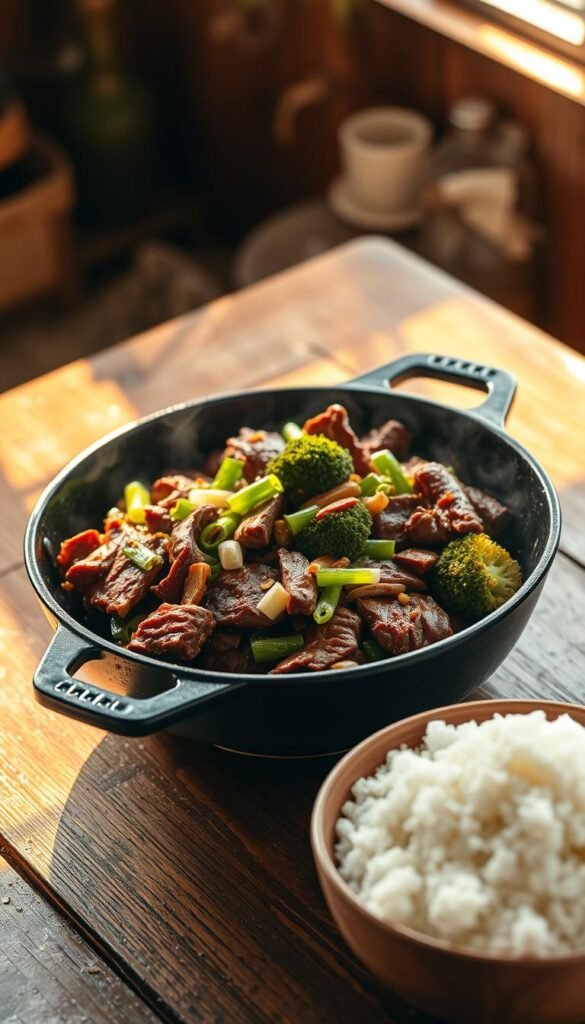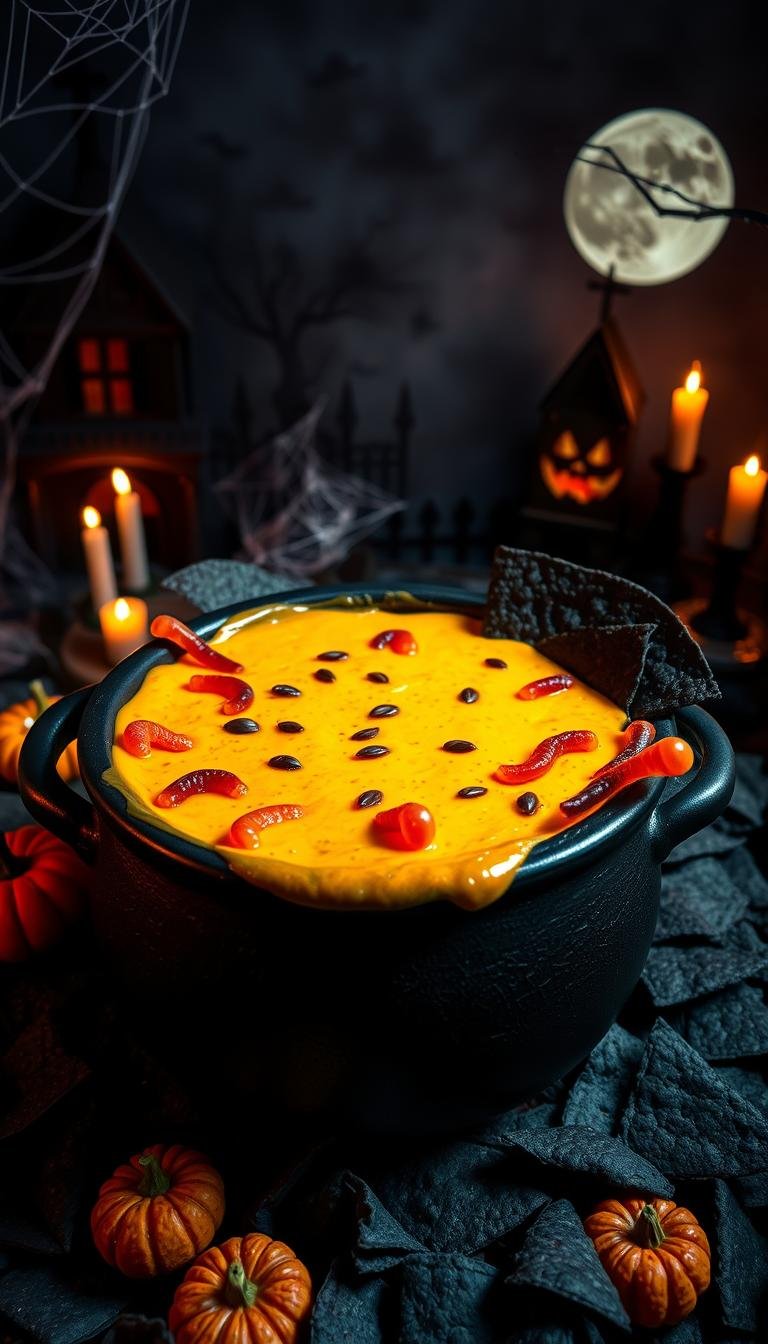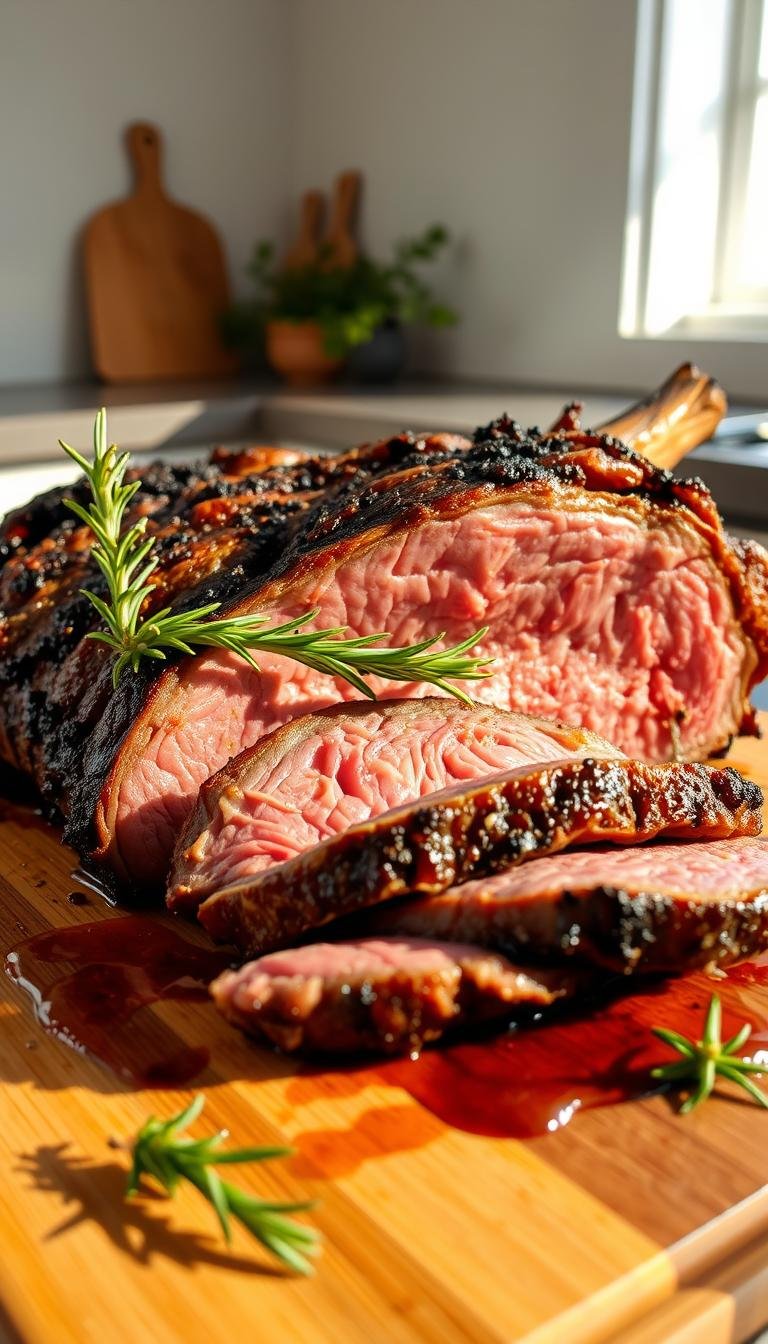Beef Dinner Ideas for Quick and Easy Meals
Surprising fact: more than 60% of home cooks say weeknight time is the main barrier to cooking, yet a handful of quick recipes cuts prep to 20 minutes or less.
This section sets the stage for practical dinner ideas that prioritize speed, pantry-friendly ingredients, and reliable techniques.
Each recipe focuses on bold flavor while using sensible shortcuts and clear steps. You’ll find methods that limit dishes and keep textures consistent so the final dish feels planned, not improvised.
We preview three fast stovetop winners—Korean ground beef bowls, Mongolian-style stir fry, and creamy one‑pot stroganoff—that deliver big taste with little effort. The emphasis is on quick-cooking cuts and ground options to speed prep while keeping meals hearty enough for the whole family.
Expect straightforward timing cues, simple substitutions, and storage tips that turn tonight’s plate into tomorrow’s lunch with minimal work.
Key Takeaways
- Fast, pantry-first recipes that finish in about 20 minutes.
- Streamlined steps that maximize flavor and minimize cleanup.
- Focus on ground or quick-cooking cuts for speed and consistency.
- Clear timing and texture cues to avoid overcooking.
- Simple swaps, storage, and pairing ideas for full meals.
Why these quick beef recipes work for busy weeknights right now
Choosing fast-cook formats makes fast results predictable. Using thin-sliced steak or ground cuts cuts prep time and keeps savory taste intact. That simple swap turns a rushed hour into a reliable, satisfying meal.
Smart mise en place—pre-measuring sauces and chopping veg before heat—lets you move through steps without pauses. A single skillet or one pot reduces cleanup and gives you more time after the table is cleared.
Pantry staples like soy sauce, brown sugar, broth, Worcestershire, and Dijon build layered flavor fast. A quick sear and a controlled simmer protect texture and keep sauces glossy.
These recipes scale easily for leftovers, let you swap vegetables or other proteins, and raise budget cuts into something special. Small finishing touches—green onions, a fried egg, or a creamy stir-in—add a restaurant feel without extra time.
- Minimal gear: one skillet or pot
- Prep once, eat twice: easy scaling
- Pre-measure to avoid mid-recipe pauses
Dinner ideas beef: three fast, flavor-packed recipes to make on the stove
These three stove-top recipes cover speed, sear, and saucy comfort so you can decide in minutes.
Korean Ground Beef Bowl: ground beef cooks fast with a sweet‑savory sauce. Serve over rice or noodles for quick comfort.
Better‑than‑takeout Mongolian: thin-sliced steak gets a high heat sear in a skillet for brown edges and glossy sauce.
Creamy One‑Pot Stroganoff: cook noodles right in the pot so they soak up sauce and cut cleanup time.
Use the table below to pick by time, texture, and pantry staples. Match protein format—ground for fast, saucy cohesion or thin-sliced for a tender sear.
| Recipe | Cook Method | Speed | Best Serve With |
|---|---|---|---|
| Korean Ground Beef Bowl | Stovetop, quick simmer | 10–15 minutes | Rice or noodles, green onions |
| Mongolian Beef | High heat sear in skillet | 12–20 minutes | Steamed rice, snap peas |
| Creamy One‑Pot Stroganoff | Simmer noodles in pot | 20–25 minutes | Egg noodles, sautéed mushrooms |
Texture cues: look for browned edges on steak, sauce that clings to ground portions, and noodles that are tender but not mushy. Start with what your pantry has and adjust sides to finish faster.
Korean Ground Beef Bowl in minutes
This Korean-style ground beef bowl delivers big flavor with minimal prep and fast skillet cooking. Lay out the core ingredients so the sauce is ready while the meat browns.
Ingredients at a glance
2 pounds ground beef, 4 cloves garlic (minced), 1/2 cup soy sauce, 1/2 cup orange juice, 1/2 cup brown sugar, 1/4 cup sweet chili sauce, 2 tsp toasted sesame oil, 1 tbsp cornstarch, 2 green onions (sliced).
Skillet, medium-high heat
Heat oil in a large skillet over medium-high heat. Add ground beef and garlic and cook 3–5 minutes until browned.
Drain excess grease. Whisk soy sauce, orange juice, brown sugar, sweet chili, sesame oil, and cornstarch in one bowl.
Pour the sauce into the skillet, simmer until slightly thickened and glossy. Serve hot over rice with steamed veggies.
Easy upgrades and storage
Add quick-cook veggies like snap peas or bell pepper for color and texture. Top with a fried egg or a sprinkle of red pepper flakes for a spicy finish.
Use low-sodium soy sauce to cut salt, and adjust sugar to taste. Refrigerate leftovers 4–5 days or freeze up to 3 months; reheat with a splash of broth to restore sauce silkiness.
- Pro tip: Assemble the sauce in one bowl while the ground browns to keep total time down to mere minutes.
- Keep an eye on sauce consistency—when it clings to the meat it’s ready to serve.
Better-than-takeout Mongolian Beef
A fast, restaurant-style Mongolian takes just a few smart steps and a hot skillet to pull together.
Pick the right cut. Use thinly sliced New York strip or flank steak cut 1/4 inch against the grain. Season lightly with salt and pepper, then toss the slices in cornstarch for a slight tenderizing crust that helps the sauce cling.
Sauté minced ginger and garlic in oil until fragrant. Pour in 1/3 cup low sodium soy sauce, 1/4 cup water, and 1/4 cup light brown sugar. Bring to a boil to dissolve the sugar and concentrate the flavor.

Skillet technique and finish
Work over medium‑high heat and sear steak in batches so pieces brown instead of steam. Return all beef to the pan, add the sauce, and simmer until glossy.
Stir in sliced green onions and cook until the sauce coats the back of a spoon. Serve over steamed rice and add quick veg like broccoli or red peppers for color.
Make-ahead and storage
- Make the sauce up to 5 days ahead; refrigerate.
- Slice steak up to 1 day before cooking to speed prep.
- Leftovers keep 3 days in the fridge or freeze for 3 months; thaw overnight and simmer to thicken before serving.
| Cut | Texture | Cook Time (per batch) |
|---|---|---|
| Flank | Lean, beefy chew when sliced against grain | 1–2 minutes per side |
| New York strip | More tender, richer flavor | 1–2 minutes per side |
| Chicken / tofu (swap) | Alternative proteins for lighter dish | 2–3 minutes per side |
Creamy One-Pot Beef Stroganoff
A single-pot method builds a creamy sauce as noodles cook, so you get rich flavor with minimal hands-on time.
Pantry-friendly ingredients
Ingredients: garlic, butter, 1/2 lb ground beef, 8 oz mushrooms, black pepper, 2 cups beef broth, 1 Tbsp Worcestershire sauce, 1/2 tsp Dijon mustard, 8 oz wide egg noodles, 1/3 cup sour cream, parsley optional.
One pot, low fuss
Sauté garlic in butter, then brown the ground and drain any excess fat. Add sliced mushrooms and pepper to build umami.
Stir in noodles, broth, Worcestershire, and Dijon. Cover and simmer 7–10 minutes until noodles are tender and most liquid is absorbed.
Fold in sour cream off heat for a silky sauce. Taste and adjust pepper or a splash more broth if needed.
Lighter, veggie-forward swaps
Boost mushrooms to increase fiber and volume. Swap part of the sour cream with Greek yogurt to cut fat while keeping body.
Use heavy cookware for even heat and avoid sticking. Serve right away; resting will thicken the sauce further.
| Step | Why it matters | Tip |
|---|---|---|
| Sauté garlic & butter | Builds base flavor | Use medium heat to avoid burning |
| Brown ground beef | Adds savory depth | Drain excess fat for lighter sauce |
| Simmer noodles in broth | Noodles absorb flavor, thicken sauce | Keep a gentle simmer and stir occasionally |
| Finish with sour cream | Creates creamy, tangy sauce | Remove from heat before folding in |
- Quick win: this method reduces cleanup and gives predictable timing.
- Garnish with parsley for color and freshness.
- Serve immediately while the sauce is silky and cohesive.
Skillet success: heat, timing, and texture tips
A hot pan and a clear rhythm make the difference between a soggy skillet and a crisp, caramelized finish.
Pan and heat basics
Preheat a large skillet over medium-high heat so proteins sear on contact. This step minimizes sticking and locks in juices in the first crucial minutes.
Batching and stirring
Avoid overcrowding the pan; cook in batches when needed to keep surface heat high and develop browning instead of steaming.
Stir strategically. Give meat time to form a crust before turning to build better texture and color.
Visible cues and seasoning
Watch for edges browning and fond forming — flip or add aromatics like garlic at the right moment so they sing without burning.
Manage salt and pepper timing to avoid drawing out moisture too early.
Tools and finish
Match pan to task: a large skillet offers spread-out heat for a sear, while a wok is ideal for fast tossing over high flame.
Keep a small pot of warm broth handy for quick sauce adjustments without cooling the pan. Finish with a quick toss over steady heat so sauces become glossy and cling to the protein.
| Action | Why it matters | Timing cue |
|---|---|---|
| Preheat skillet | Immediate sear, less sticking | 2–3 minutes until shimmering |
| Cook in batches | Better browning, consistent texture | Pieces brown in 1–3 minutes per side |
| Add garlic late | Prevents burning, keeps flavor bright | Add in final 30–45 seconds before finish |
| Reduce sauce | Glossy cling, balanced salt | Reduce until sauce coats back of spoon |
Perfect pairings: rice, noodles, and easy veggies
Match your main skillet flavors with simple sides that finish fast and look vibrant on the plate.
Steamed rice soaks up sauce and gives a neutral base that highlights balance. It’s the easiest choice when you want the glaze or pan juices to sing.
Noodles bring different textures. Choose chow mein or ramen for a slurpable bite, or wide egg noodles when you want a heartier chew. Reserve a spoonful of pasta water to loosen and bind the sauce at the end.
Keep the veggies quick-cooking: broccoli florets, snap peas, or asparagus take minutes and add color and crunch. For extra fiber, toss a handful of spinach or broccoli into the pan near the finish.
- Aim for color and contrast to complement tender beef and rich sauce.
- Season vegetables lightly so the main sauce remains the star.
- Choose sides that cook in the same timeframe to serve everything hot together.
| Side | Best Use | Cook Time |
|---|---|---|
| Steamed rice | Absorbs sauce, neutral base | 12–20 minutes |
| Chow mein / Ramen | Slurpable, carries sauce | 3–5 minutes |
| Wide egg noodles | Hearty texture, soaks sauce | 8–10 minutes |
| Broccoli, snap peas, asparagus | Quick veg for crunch and color | 3–6 minutes |
Prep, storage, and leftovers that taste like day one
A few smart steps after cooking protect texture and flavor for later plates.
Quick prep before service saves time later: batch sauces, slice proteins, and cool food fast. Label containers with the date and portion into 1-cup servings for easy reheating and less waste.
Refrigerate and freeze within safe windows. Saucy ground beef stays good 4–5 days; sliced‑steak dishes keep about 3 days. Freeze either type up to 3 months in flat bags to speed thawing.

Reheat and finishing step
Rewarm gently on the stove or in the microwave. Add a splash of broth to bring a tightened sauce back to glossy, saucy texture.
Practical tips
- Thaw frozen portions overnight, then simmer a few minutes until hot—usually a couple of minutes per portion.
- Keep rice separate; re-steam or microwave with a few drops of water for best texture.
- Make Mongolian sauce up to five days ahead and slice steak a day early to cut active cooking time.
| Dish | Fridge (days) | Freezer (months) | Best reheat step |
|---|---|---|---|
| Korean ground beef | 4–5 days | 3 months | Splash broth, warm on stove |
| Mongolian sliced steak | Up to 3 days | 3 months | Thaw overnight, simmer to thicken |
| Cooked meat & sauce (mixed) | 3–4 days | 3 months | Freeze flat; reheat gently |
Plan one cook step to make multiple meals. These small tips cut minutes and keep plates tasting fresh.
Flavor-first, sodium-smart: easy ways to balance calories, fat, and salt
Small swaps and deliberate measures let you keep big flavor while trimming sodium, calories, and fat.
Control sodium early: choose low sodium soy sauce and add a pinch of salt only at the end. This keeps concentrated sauces from becoming overly salty while preserving bright umami.
Trim fat and calories: swap one-third of the sour cream in stroganoff with Greek yogurt or skim and drain excess fat after browning. These simple moves cut fat and calories without losing creaminess.
Stretch portions with vegetables: increase quick-cook veggies in the pan to add fiber and volume. More vegetables mean you can serve slightly less protein and still feel satisfied.
- Measure sweeteners by the tablespoon and reduce slightly—cornstarch and reduction keep sauce body.
- Use stir-fry technique to limit oil; quick, high-heat sears minimize oil absorption.
- Swap in lean chicken for lighter protein when desired; sauces and methods translate well.
- Finish with green onions or fresh herbs to amplify flavor without more salt or fat.
Strategy: pick flavorful stocks and umami ingredients so your sauce tastes robust even with modest sodium. These small, sustainable tweaks add up to a lighter plate that still delivers the rich taste you want.
Conclusion
strong, Wrap up your weeknight plan with three reliable recipes that deliver comfort and speed.
Choose the recipe that matches tonight’s pantry and time — whether a one pot stroganoff or a sizzling skillet dish, the methods keep cleanup light and results consistent.
Pair each main with rice, noodles, or quick vegetables to complete the meal without extra work. Save or double sauces to build a make-ahead rotation that speeds future cooking.
Use heat, timing, and texture cues to get the right sear and glossy sauce. Smart storage and gentle reheating help leftovers taste like day one.
These recipes celebrate the versatility of ground beef and thin-sliced cuts so you can reach for a dependable, comforting plate any night.






